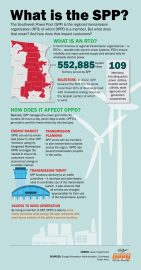What you need to know about the Southwest Power Pool

In 2009, OPPD joined the Southwest Power Pool (SPP), a regional transmission organization (RTO) that spans from Texas to North Dakota and west to Montana.
RTOs are independent, membership-based, nonprofit organizations that operate bulk electric power systems across much of North America, according to the U.S. Energy Information Administration. There are nine RTOs operating in North America.
SPP manages the bulk electric grid – the main electric grid in North America, consisting of the Western and Eastern Interconnections including generating resources and high-voltage transmission equipment. The RTO also operates a wholesale market and plans transmission on behalf of its 109 utilities and transmission companies in 15 states.
SPP covers a 552,885-square-mile territory that contains more than 72,000 miles of transmission lines. It is made up of a diverse group that includes investor-owned utilities, marketers, electric cooperatives, municipals, companies that own transmission, public power utilities, and state and federal agencies.
The organization was formed in 1941, when 11 companies pooled resources to guarantee that power kept flowing, uninterrupted, to Jones Mill outside Malvern, Arkansas. The mill was a critical producer of aluminum in support of the American war effort during World War II.
Membership
As an SPP member, OPPD has certain generation requirements it must uphold, said Colin Sniff, OPPD’s Energy Regulatory Policy manager. SPP requires OPPD and other load responsible entities to meet its peak load, plus have a certain amount of energy – currently 15% – in reserve capacity above that peak load demand that can be called upon if needed. SPP increased the planning reserve margin from 12% to 15% in 2023 to ensure SPP can reliably serve the footprint’s forecasted peak load. The amount of winter peak load capacity is expected to increase above 15% in the coming years.
Much like an air traffic controller, Sniff said, SPP does not own but manages the power grid around the clock ensuring the grid’s safety and reliability when bad weather strikes and plants or transmission lines go down.
Cost savings
Through its wholesale electricity market, SPP facilitates the selling and purchasing of electricity across its territory.
The wholesale energy market makes it possible for OPPD and other members to sell their wholesale power to other power pool participants using the Integrated Marketplace. SPP also ensures the availability of economical and reliable energy to consumers.
Last spring, SPP became the first RTO to serve more than 90% of its energy load with renewable energy sources, the largest portion of which is wind, at 37.5%.
Reliable access to power
To help maintain the health and future viability of the grid, SPP works with its members to plan transmission projects across the region. SPP employs planning processes to identify and analyze system limitations and manage transmission upgrades to benefit the greater region. OPPD has several transmission projects in the works.
A robust transmission system offers more continuous, reliable access to power around the SPP region for its members as well as for entities that aren’t members, such as utilities in adjacent RTOs that could use the power to supplement their existing capacity or energy production. During a high load period or to meet an energy shortage, a neighboring utility like MISO (Midcontinent Independent System Operator) or one of their member utilities, could purchase energy from SPP.
SPP membership allows OPPD to purchase renewable energy from wind facilities located inside the SPP footprint at no wheeling cost – or money one electrical system must pay another electrical system for transmitting energy across that system’s lines – if SPP transmission capacity is available.


Jason Kuiper joined OPPD as a communications specialist in 2015. He is a former staff writer and reporter at the Omaha World-Herald, where he covered a wide range of topics but spent the majority of his career covering crime. He is a graduate of the University of Nebraska at Omaha and has also appeared in several true crime documentary shows. In his free time he enjoys cooking, spending time with his wife and three children, and reading crime novels.
View all posts by Jason Kuiper >







